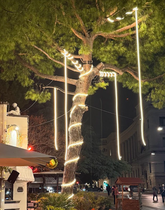VynEL™ Custom Panel Shapes and Applications
At first glance Electroluminescent Wire and Laser Wire™ cabling from Ellumiglow may seem to be similar technologies. They are both different forms of accent lighting technology and can be used for a variety of applications such as clothing and costuming, signage, safety, event and retail lighting. There are advantages to both types of accent lighting, but it is smart to take a look at their similarities and differences when trying to decide what is best for your specific project application.
First off, EL Wire is made using a copper core wire. The core is then coated in phosphor, and fine angel hair wires wrap around the phosphor layer. The core is the reason that the wire is able to light up, and when high frequency power is applied to this core it is able to illuminate the phosphor. This copper and phosphor core is covered in a colored plastic jacketing which allows users to work with different colors of wire.
Laser Wire™ cabling itself on the other hand is made with a clear glass optical core. This allows for the light to be reflected and refracted as it travels down the length of cable. This also means that there is no electric current travelling through the wire. Unlike Electroluminescent material, laser powered accent lighting is able to radiate light rather than transmitting it.
Laser Wire™ is at least 4 times brighter than EL Wire, and sometimes can be up to 10 times the brightness. If your project needs to be brighter, this may be what you’ve been searching for! You can also change the color of the wire after you’re done installing it by unscrewing the connector and attaching up a different colored Opal Drive Laser Module. This also makes it easy to replace the Module itself if anything is to happen to it, and it is easy for you to be up and running again. No more worry about EL wire failure or having to re-solder or replace the whole strand. This makes Laser Wire™ a logical next step in the world of design, coming in handy for permanent projects and installations, or anticipated long term use.




